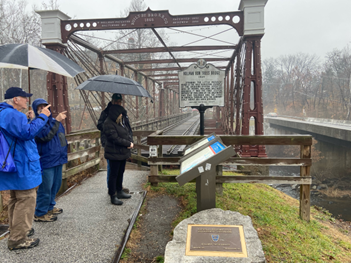
On Sunday, December 10, 2023, members of ASCE’s National Capital Section‘s Historic and Heritage Committee, braved the much needed rain to visit three important civil engineering structures to national capital region and the nation. These 19th century marvels included the Bollman Truss Bridge, Savage Mill and the Thomas Viaduct. Tours were spearheaded and led by Bernie Dennis. Bernie provided extensive background to the attendees, including articles of research from ASCE-NCS newsletters from March and May 2011 highlighting the Bollman Truss and Thomas Viaduct, respectively. Furthermore, he provided an excellent summary of the landmark nomination process and the role of the committee and its members in recognizing these two sites as National Historic Engineering Landmark (NHCEL).
The Bollman Truss Bridge in Savage, Maryland is a paramount edifice to the civil engineering profession. Designed by self-taught engineer, Wendel Bollman, of Baltimore, built the first iron truss bridge and obtained a patent for his unique design in 1852. His design integrated an array of tension bars spanning from end posts to independently support each floor beam, improve capacity for transient moving loads and additional redundancy. Additionally, the design selected different metals for differing applied forces, such as cast iron for compression members and wrought iron for tension members. Furthermore, his design used replaceable parts and bolted connections to permit future maintenance and repair efforts. The current bridge was constructed for the B&O railroad in 1869 and relocated to its present location in 1888 to serve the textile industry at Savage Mill. It is the last remaining Bollman Truss Bridge and as a result of its significant was designated in 1966 as the first NHCEL.
Recognizing a need for a dry warm place, the group then toured the nearby Savage Mill, a historic textile mill complex listed on the National Register of Historic Places in 1974 and the site of the Savage Mill Historic District. The mill buildings served as a cotton and duck canvass manufacturer from the early 19th century through World War II. Major building campaigns range from 1822 to 1916. Its primary load-carrying elements include of unreinforced, load-bearing, stone and brick masonry shear walls which support multiple wood-framed floors and trusses roof systems. With the preservation efforts and sensitive design of its new life as a shopping center, it is easy for visitors to see its contribution to the region through its roof monitors, sizable wood members and 2.5” thick floor boards.
Ten miles to the north led to the last site visit of the day. The Thomas Viaduct near Relay, Maryland is a curvilinear, stone arch railroad viaduct built from 1833 to 1835 by the Baltimore and Ohio (B&O) Railroad to cross the Patapsco River and be the first railroad to serve Washington, D.C. This interesting structure was designed by Benjamin Henry Latrobe, Jr., son of the well-known architect. Its rustic masonry, tapered piers and gentle curve can be easily seen near the entrance to the Patapsco Valley State Park. It still remains in service after almost 190 years, a tribute to its robustness and durability. For its significance the Thomas Viaduct was listed as a NHCEL in 2011.
If you’re interested in learning more about local engineering heritage and or participating in recognizing engineering marvels, please reach out to the NCS History and Heritage Committee.
Text by Bernie Dennis. Photo by John Dumsick with permission for use in the article.
